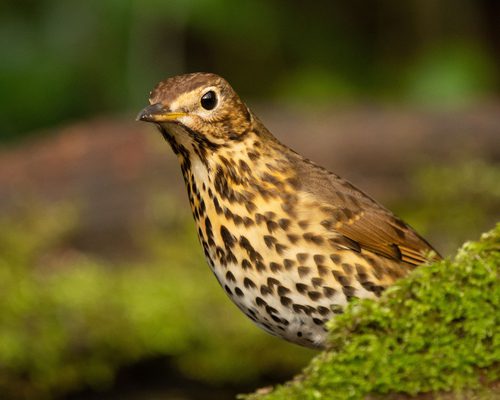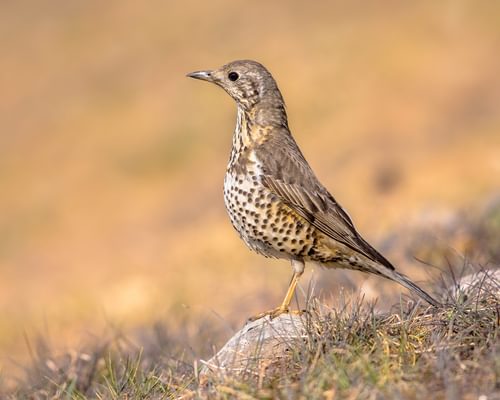Redwing
Near ThreatenedTurdus iliacus
Visual Identification
Appearance
The Redwing is a small thrush with distinctive rusty-red flanks and underwing. Its upperparts are brown, while the underparts are white with dark streaks. A prominent pale stripe above the eye contrasts with its dark brown head.
Both sexes look similar, both with black eyes, a yellow bill with a black tip, and pinkish legs. Juveniles appear similar to adults but have pale streaks on the upperparts and lack the characteristic rusty flanks.
Winter plumage is slightly duller than breeding plumage, but the red flanks remain a key identifier year-round.
Size
Length
20cm to 24cm
Wingspan
33cm to 35cm
Weight
50g to 75g
Colours
Males and females have similar plumage
Primary Colour
Brown White
Secondary Colour
Red Buff
Beak Colour
Brown
Leg Colour
Pink
Habitat and Distribution
Habitats
Woodland
Garden
Wetland
Coastal
Urban
Farmland
Grassland
Desert
Tundra
Rainforest
Mountain
Savanna
Distribution
Redwings breed in northern Europe and Asia, from Iceland to eastern Siberia. They prefer open woodlands, forest edges, and tundra with scattered trees for nesting. During winter, they migrate south to milder climates.
In the UK, Redwings are common winter visitors, arriving in large numbers from October onwards. They can be found in a variety of habitats including fields, parks, and gardens across the British Isles. They rarely forage in towns and cities, so head to the countryside for your best chance.
Elevation Range
Up to 1,000 meters
Climate zones
Temperate, Subarctic
Distribution Map
This map gives you a rough idea of where you might spot a Redwing. The coloured areas show countries where these birds have been seen.
A few things to keep in mind:
- Birds might not be everywhere in the coloured areas, for example, they may be present around the coast of that country
- Where birds live can change with seasons and available food
- This map is quite simple - it doesn't show exact locations
We're working on making our maps even better! Soon, we hope to show you:
- More detailed maps for bigger countries, including state and region
- How birds move around during different seasons
Distribution by Region
Behaviour and Ecology
Bird Attributes
This feature is in beta. We'd love your feedback to improve it!
Share your thoughtsBird Attributes Explained
Our bird attributes system rates various aspects of a bird's capabilities on a scale of 0-100, based on data from field observations, scientific studies, and expert knowledge.
Attribute Categories:
- Agility: Manoeuvrability, speed, and grace in flight or movement.
- Strength: Physical power, often correlating with size and hunting abilities.
- Adaptability: Ability to thrive in various environments or changing conditions.
- Aggressiveness: Territorial behaviour and assertiveness, particularly during breeding seasons.
- Endurance: Stamina, often seen in migration patterns or foraging behaviours.
Understanding the Ratings:
- 0-20: Very Low
- 21-40: Low
- 41-60: Average
- 61-80: High
- 81-100: Very High
Remember, these attributes are relative to other bird species and don't necessarily indicate superiority.
Hover over the icon next to each attribute for more information.
Tap the icon next to each attribute for more information.
Agility
Reflects the bird's manoeuvrability, speed, and grace in flight or movement.
The Redwing demonstrates high agility with its quick, jerky movements whilst foraging and its ability to navigate long-distance nocturnal migrations. Their excellent night vision also contributes to their nimble nature.
Strength
Indicates the bird's physical power, often correlating with size and hunting abilities.
As a small thrush, the Redwing's strength is moderate. Whilst capable of long-distance flights, they lack the powerful build of larger birds. Their ability to probe for invertebrates suggests decent strength for their size.
Adaptability
Represents the bird's ability to thrive in various environments or changing conditions.
Redwings show remarkable adaptability, switching their diet seasonally from invertebrates to fruits, and migrating vast distances to suitable habitats. Their ability to thrive in various environments, from tundra to urban parks, further demonstrates their adaptability.
Aggressiveness
Measures the bird's territorial behaviour and assertiveness, particularly during breeding seasons.
During breeding season, male Redwings become fiercely territorial, displaying aggressive behaviour towards intruders. However, their tendency to form mixed flocks in winter suggests a more sociable nature outside breeding periods.
Endurance
Reflects the bird's stamina, often seen in migration patterns or foraging behaviours.
Redwings exhibit exceptional endurance, capable of travelling up to 800 km in a single night during migration. Their ability to undertake long-distance flights from northern breeding grounds to southern wintering areas demonstrates remarkable stamina.
Diet
Redwings primarily feed on invertebrates such as earthworms, insects, snails, and spiders during the breeding season. They find a lot of their prey searching through leaf litter.
In autumn and winter, they switch to a more frugivorous diet, consuming berries and fruits, particularly rowan, hawthorn, and holly.
These birds rarely visit bird feeders, although they could be tempted with apples and mealworms in snowy conditions when they are more likely to venture into gardens.
Behaviour
Redwings are often seen foraging on the ground in flocks, probing for invertebrates with quick, jerky movements. During migration, they travel in large groups, often at night.
In breeding territories, males become fiercely protective, chasing away intruders with aggressive displays.
Vocalisation
The Redwing's call is a thin, high-pitched 'tseep' or 'sip', often heard during nocturnal migration. Its song is a varied, melodious warble reminiscent of other thrushes but with a distinctive, slightly melancholic quality. In flight, they produce a soft, whistling 'seeip' sound.
Nesting & Breeding
Redwings form monogamous pairs during the breeding season, which typically begins in May. Males establish territories and attract females with melodious songs.
Nests are cup-shaped structures made of grass, moss, and mud, usually placed low in trees or shrubs. Females lay 4-6 pale blue eggs with brown speckles. Both parents share incubation duties.
The incubation period lasts about 13 days, with chicks fledging after another 10-14 days. Pairs often raise two broods per season in favourable conditions.
Lifespan
The Redwing typically lives for 2 to 5 years, with a maximum recorded lifespan of 18.8 years.
Like all birds, lifespan can be affected by factors including predation, habitat quality, disease, and access to food sources.
Conservation and Status
Global Conservation Status
Listed as Near Threatened, Redwing populations are declining in parts of their range due to habitat loss and climate change.
Conservation efforts focus on preserving breeding habitats in northern Europe and maintaining suitable wintering grounds in southern regions.
Birdwatching Tips
- Look for Redwings in open fields and parks during the winter months
- Listen for their thin, high-pitched call, especially at night during migration
- Observe flocking behaviour with other thrush species like Fieldfares
- In the UK, check berry-laden hedgerows and orchards in autumn and winter
Additional Information
Quick Facts
Other names:
Red-winged Thrush
Family:
TurdidaePredators
Main predators of Redwings include Sparrowhawks, Peregrine Falcons, and other birds of prey. Ground-nesting individuals are also vulnerable to foxes and domestic cats.
Did You Know?
- Redwings can travel up to 800 km (around 500 miles) in a single night during migration.
- They have excellent night vision, allowing them to navigate and forage in low light conditions.
- Redwings are known to form mixed flocks with Fieldfares, another thrush species, during winter.
Was this bird profile helpful?
Your feedback helps us improve our content
Thanks for your feedback!
Your input helps us improve our content.
Community Experience
Community Ratings
No ratings yet - be the first to rate this bird!
Latest Community Reviews
No reviews yet
Sign in to be the first to review
Community Reviews
Create Your Free Account Welcome Back!
Join our community to rate birds and share your experiences. Creating an account is completely free and only takes a minute. Sign in to your account to rate birds and share your experiences with our community.
Your information is secure and will never be shared.
By creating an account, you agree to our Privacy Policy.
Similar Birds
References
- 2 3 4
website: BirdLife International. 2017. Turdus iliacus (amended version of 2016 assessment). The IUCN Red List of Threatened Species 2017: e.T22708819A110990927.
View source - 1
journalArticle, 2006: Moller, Sociality, age at first reproduction and senescence: comparative analyses of birds, J Evol Biol, 19:682-689


